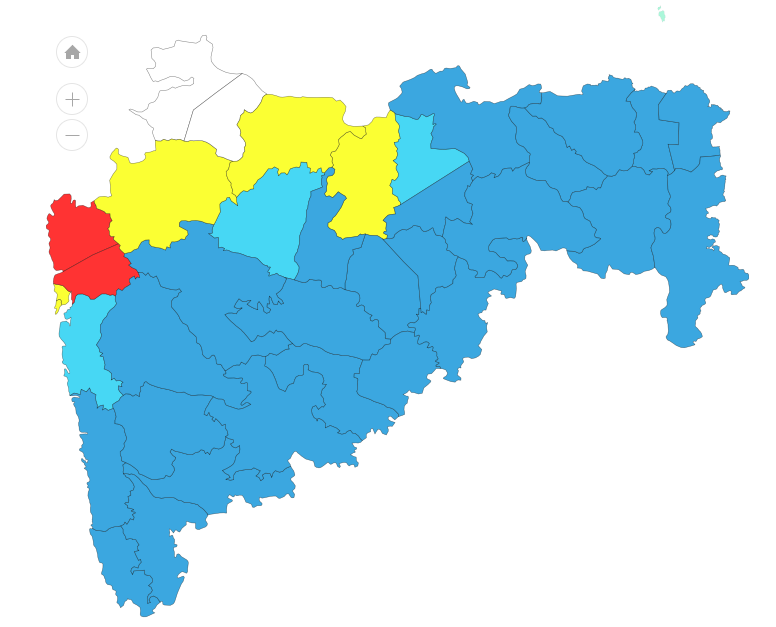After Telangana, heavy rainfall batters Maharashtra; at least 27 dead, major kharif crops lost
Between October 8 and October 14, Maharashtra received 131% above its normal rainfall. The incessant rainfall has led to floods. Standing kharif crops of soybean, toor and cotton, and horticulture crops of pomegranate and grapes have been washed away.


Between October 8 and October 14, Solapur received 256% above its normal rainfall leading to floods. Pic: By arrangement
Every year, farmers in Solapur district of Maharashtra eagerly await the return monsoon because their main kharif crops of soybean and toor (pigeon pea) depend on it. This year, the incessant rainfall in the return monsoon in the past week has washed away their standing crops and devastated the farmers, who were already facing losses due to the COVID-19 pandemic.
“All our crops are either fully submerged in the flood waters or washed away. The fertile topsoil has gone too. There is a complete loss of soybean and toor crop. Sugarcane is also affected and so is grape,” Nitin Atkare of Barsi taluka in Solapur, about 370 kilometres (km) from Mumbai, told Gaon Connection.
Since October 8, large parts of Maharashtra have received ‘large excess’ rainfall, which has not only unleashed floods in the state, but has also wiped away standing kharif crops. As per the India Meteorological Department’s (IMD) rainfall data, between October 8 and October 14, as against a normal rainfall of 19.3 millimetre (mm), the state has received 44.5 mml, registering a rainfall departure of 131 per cent.
At least 27 people have died in rain-related incidents, while the state administration, along with the National Disaster Response Force (NDRF), continues to evacuate people to safer locations.

Meanwhile, heavy rainfall has also caused mayhem in the east coast of the country, where a deep depression in the Bay of Bengal caused incessant rainfall in Andhra Pradesh and Telangana, leading to the deaths of at least 50 people. The IMD had given a timely forecast of the depression and how as it moved westwards, it would bring heavy rains in parts of Maharashtra, Goa and Karnataka. All the three states had been put on high alert.
“The state government had issued a press note warning of the heavy rainfall, which we received through WhatsApp. Although our lives are saved, farmers have suffered huge losses as all their crops are lost,” said Atkare.
The Maharashtra state machinery is trying to assess crop damage in its rain-affected districts. Large excess rainfall and crop losses have been reported across Marathwada, Vidarbha and south Madhya Maharashtra regions of the state. As per preliminary reports (a conservative estimate), standing crops on at least 450,000 hectares have been damaged. Some of the major crops affected are soybean, maize, toor, sugarcane, pomegranate and grapes.

“On October 8 and 9, we received very heavy rainfall that destroyed some of our crops. Thereafter, on October 11, we again received heavy rainfall. More crops were destroyed. The final blow came on October 13-14, when incessant rainfall flattened everything in our fields,” Manik Kadam, a resident of Parbhani, and president of the Marathwada division of Swabhimani Shetkari Sanghatana, a state-level farmers’ organisation, told Gaon Connection.
“Farmers were preparing to harvest their kharif crops of soybean and cotton. Both have been washed away. I lost my entire soybean crop on four acre [1.6 hectare] land,” he said. “Immediately after crop losses due to the October 8-9 rainfall, we collected crop loss details and approached the crop insurance company for Parbhani district. However, so far, no one has come to do panchnama. Despite paying premium, farmers face a tough time in claiming crop insurance from private companies,” he added.

When it rains, it pours
As per the IMD’s rainfall data, till the week ending October 7, large parts of Maharashtra had received ‘deficient’ or ‘large deficient’ rainfall. For instance, Latur, Osmanabad and Parbhani districts in the drought-prone Marathwada region had rainfall departure of minus 99 per cent, minus 94 per cent and minus 62 per cent, respectively. Similarly, Solapur and Pune districts, both at present flooded, had a rainfall departure of minus 74 per cent and minus 82 per cent, respectively (see table: Rainfall departure in districts of Maharashtra for week ending October 7).
Table: Rainfall departure in districts of Maharashtra for week ending October 7

However, the very next week, there was a complete swing, and the districts facing deficient rainfall were inundated due to heavy rainfall between October 8 and October 14.
The IMD’s rainfall data shows that in the last week, between October 8 and October 14, Latur, Parbhani, Osmanabad and Beed in Marathwada received 335 per cent, 242 per cent, 453 per cent and 190 per cent above their normal rainfall, respectively. During the same week, Solapur, Sangli and Pune received 256 per cent, 199 per cent and 143 per cent above their normal rainfall, respectively.
Overall, between October 8 and October 14, the Vidarbha region of the state recorded a rainfall departure of 295 per cent, Marathwada of 622 per cent, and Madhya Maharashtra of 102 per cent (Map: Large excess rainfall in several districts of Maharashtra between October 8 and October 14.). The state received 131 per cent above its normal rainfall in this time period. Predictably, there were floods and crop losses.
Map: Large excess rainfall in several districts of Maharashtra between October 8 and October 14.

Source: IMD
In the month of October, from October 1 to October 16, as against its normal rainfall of 50.5 mm, Maharashtra has received 91.6 mm rainfall, a rainfall departure of 81 per cent (‘large excess’ rainfall category). The highest rainfall departure has been recorded in Osmanabad district of Marathwada at 143 per cent, followed by Sindhudurg (126 per cent), Gondiya (73 per cent), Sangli (69 per cent), Solapur (66 per cent) and Parbhani (65 per cent).
Farmers caught in an endless cycle of losses
Since Solapur district falls in the rain-shadow area of Maharashtra, it receives scanty rainfall and a large chunk of the farmers practice rainfed agriculture. The southwest monsoon does not bring as good rains as the return monsoon brings. Hence, a large number of farmers sow their kharif crops late to benefit from the return monsoon.
“As against other parts of the state where farmers keep their fields ready by June and sow crops with the arrival of the monsoon, in Solapur district, most farmers do late kharif sowing in September in the hope that the rains of the return monsoon will be beneficial to their crops,” informed Shrinivas Deshpande, who hails from Pandharpur in Solapur. “But, if anything goes wrong in late kharif sowing, they lose the entire kharif season and only have the rabi season to bank upon. But losses in kharif crop mean no capital in hand for rabi sowing,” he added.
This is exactly the present condition of most farmers in Solapur. They have lost their entire kharif crops. Because of the COVID-19 pandemic, their incomes were already affected, and most may have no money for planting the rabi crops of chana (gram) and jowar (sorghum).

“This year, the arrival of monsoon brought us good rains, so we sowed soybean early. But, the seeds were of inferior quality and the pods were empty, so many farmers undertook a second sowing of soybean. The second crop was good and we were hoping to save its seeds for the next kharif season, but the rains have washed away everything,” lamented Atkare.
“Almost 95 per cent of the crop in Solapur district is submerged under flood waters. The government is carrying out an official estimation of the losses,” informed Rajanish Joshi, a resident of Solapur.
Incidentally, despite being a rain shadow area, Solapur has the highest number of sugar factories (34) in Maharashtra. Sugarcane is one of the most water-intensive crops, known to cause repeat droughts in parts of Maharashtra as all the groundwater is sucked dry to feed this water-guzzling crop.
Apart from the kharif crops, horticulture crops have also suffered huge losses in Solapur and Sangli. “Farmers who raise pomegranate and grapes have lost their entire crop in both the districts,” said Deshpande.

